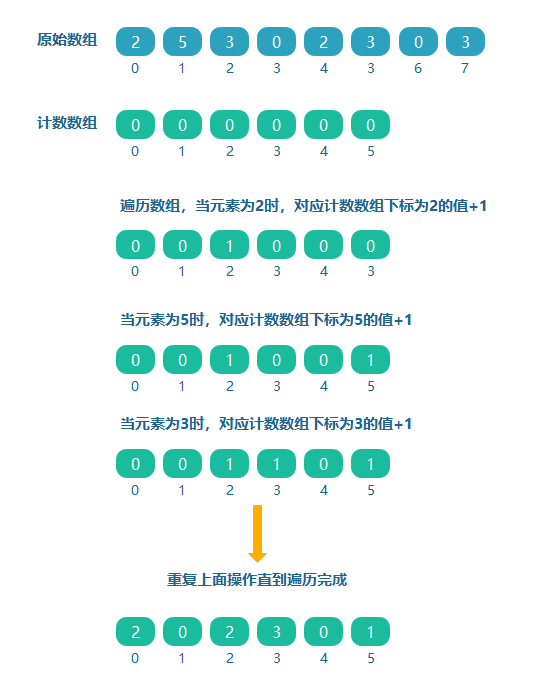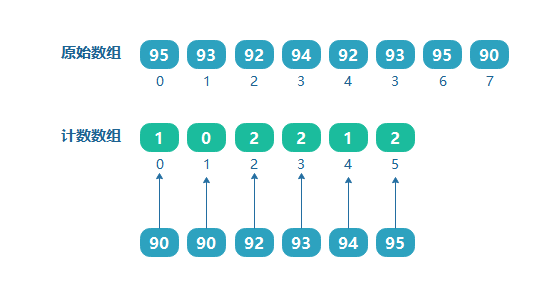计数排序
一种非比较排序。计数排序对一定范围内的整数排序时候的速度非常快,一般快于其他排序算法。但计数排序局限性比较大,只限于对整数进行排序,而且待排序元素值分布较连续、跨度小的情况。
如果一个数组里所有元素都是整数,而且都在 0-k 以内。对于数组里每个元素来说,如果能知道数组里有多少项小于或等于该元素,就能准确地给出该元素在排序后的数组的位置。
如给定一个 0~5 范围内的数组[2,5,3,0,2,3,0,3],对于元素 5 为其中最大的元素,创建一个大小为(5-0+1 = 6)的计数数组,如果原数组中的值对应计数数组的下标,则下标对应计数数组的值加 1。
问题
上面是通过数组的最大值来确定计数数组的长度的,但如果需要对学生的成绩进行排序,如学生成绩为:[95,93,92,94,92,93,95,90],如果按照上面的方法来处理,则需要一个大小为 100 的数组,但是可以看到其中的最小值为 90,那也就是说前面 0~89 的位置都没有数据存放,造成了资源浪费。
如果我们知道了数组的最大值和最小值,则计数数组的大小为(最大值 - 最小值 + 1),如上面数组的最大值为 99,最小值为 90,则定义计数数组的大小为(95 - 90 + 1 = 6)。并且索引分别对应原数组 90~95 的值。我们把 0~90 的范围用一个偏移量来表示,即最小值 90 就是这个偏移量。
代码实现
public class CountSort { public static final int[] ARRAY = {2, 5, 3, 0, 2, 3, 0, 3}; public static final int[] ARRAY2 = {95,93,92,94,92,93,95,90}; //优化前 private static int[] sort(int[] array) { if (array.length < 2) return array; //找出数组的最大值 int max = array[0]; for (int i : array) { if (i > max) { max = i; } } //初始化一个计数数组且值为0 int[] countArray = new int[max + 1]; for (int i = 0; i < countArray.length; i++) { countArray[i] = 0; } //填充计数数组 for (int temp : array) { countArray[temp]++; } int o_index = 0;//原数组下标 int n_index = 0;//计数数组下标 while (o_index < array.length) { //只要计数数组的下标不为0,就将计数数组的值从新写回原数组 if (countArray[n_index] != 0) { array[o_index] = n_index;//计数数组下标对应元素组的值 countArray[n_index]--;//计数数组的值要-1 o_index++; } else { n_index++;//上一个索引的值为0后开始下一个 } } return array; } //优化后 private static int[] sort2(int[] array) { if (array.length < 2) return array; //找出数组中的最大值和最小值 int min = array[0], max = array[0]; for (int i : array) { if (i > max) { max = i; } if (i < min) { min = i; } } //定义一个偏移量,即最小值前面0~min的范围,这里直接用一个负数来表示 int bias = 0 - min; //初始化一个计数数组且值为0 int[] countArray = new int[max - min + 1]; for (int i = 0; i < countArray.length; i++) { countArray[i] = 0; } for (int temp : array) { countArray[temp + bias]++; } //填充计数数组 int o_index = 0;//原数组下标 int n_index = 0;//计数数组下标 while (o_index < array.length) { if (countArray[n_index] != 0) { array[o_index] = n_index - bias; countArray[n_index]--; o_index++; } else { n_index++; } } return array; } public static void print(int[] array) { for (int i : array) { System.out.print(i + " "); } System.out.println(""); } public static void main(String[] args) { print(ARRAY); System.out.println("============================================"); print(sort(ARRAY)); System.out.println("=================优化排序===================="); print(ARRAY2); System.out.println("============================================"); print(sort2(ARRAY2)); }}
复制代码
时间复杂度
很明显,在排序过程中,我们至少遍历了三次原始数组,一次计数数组,所以它的复杂度为Ο(n+m)。因此,计数排序比任何排序都要块,这是一种牺牲空间换取时间的做法,因为排序过程中需要用一个计数数组来存元素组的出现次数。
算法稳定性
在新建的计数数组中记录原始数组中每个元素的数量,如果原始数组有相同的元素,则在输出时,无法保证元素原来的排序,是一种不稳定的排序算法。















评论